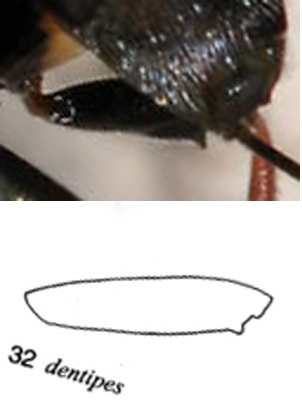Diptera.info :: Identification queries :: Other insects, spiders, etc.
|
Mystery disk with hymenoptera (= Monodontomerus)
|
|
| John Carr |
Posted on 17-10-2013 12:47
|
|
Super Administrator Location: Colorado, USA Posts: 10528 Joined: 22.10.10 |
I found this on a rock wall beside a parking lot in suburban Massachusetts, USA. It contained hymenoptera coccoons about 1 cm long and was covered in 4 mm Torymidae, probably parasitoids or hyperparasitoids. I could not get an ID on BugGuide (http://bugguide.n...iew/192545), but there was a comment that the fibers of the white object might be synthetic. The disk was spongy, not hard.
John Carr attached the following image:  [113.47Kb] Edited by John Carr on 27-10-2013 00:13 |
| Steve Crellin |
Posted on 18-10-2013 13:23
|
|
Member Location: Isle of Man Posts: 41 Joined: 01.09.04 |
Hi John, I mentioned your query to a friend with an interest in these little parasitic wasps and he replied with the following: "I fear that any attempt to name the mystery object on Diptera info would only be a guess. I thought initially it might be wool spun by parasitic larvae of the primary parasitoid that emerged from a lep larva as they formed cocoons eg. an Apanteles (Braconidae) or similar genus. Usually the outline of individual cocoons is evident so there must be a better answer. I worked a bit with phytophagous species of Torymidae in Florida and South America and doubt that this one belongs to that group of species. The best lead would probably to get the torymid identified and check what host records are known for that species." Sadly, it doesn't provide an answer beyond those you've already received on the other forum. If you do get an answer please let me know so I can pass the news on to my friend. Steve Steve Crellin steve_crellin1@hotmail.co.uk Isle of Man |
|
|
|
| empeejay |
Posted on 19-10-2013 09:24
|
|
Member Location: Posts: 234 Joined: 15.05.06 |
The parasites are almost certainly a Monodontomerus species but I have no idea what the disc could be. Grissell revised the New World Monodontomerus species in 2000 and listed various hosts in Diptera, Lepidoptera and Hymenoptera. |
|
|
|
| John Carr |
Posted on 19-10-2013 12:43
|
|
Super Administrator Location: Colorado, USA Posts: 10528 Joined: 22.10.10 |
Monodontomerus dentipes is released to control invasive Diprionidae. Maybe this disk is a release mechanism, an artificial structure to support parasitized cocoons. |
| John Carr |
Posted on 29-10-2013 22:19
|
|
Super Administrator Location: Colorado, USA Posts: 10528 Joined: 22.10.10 |
Current leading theory is Monodontomerus montivagus parasitizing Anthidium. |
| empeejay |
Posted on 30-10-2013 18:00
|
|
Member Location: Posts: 234 Joined: 15.05.06 |
Monodontomerus dentipes is decribed by Grissell as "unique in the subapical placement of the femoral tooth". I've created a crude image comparing the hind femur of your insect with that of dentipes, which seems to suggest that it is not that species. Another feature of dentipes is that the ovipositor is about 0.5 x length of the metasoma, which again is evidently not the case. There is no other species listed as parasitizing Diprionidae. That probably doesn't help much but suggests you may be right in looking for an alternate host. empeejay attached the following image:  [63.46Kb] |
|
|
|
| Jump to Forum: |













